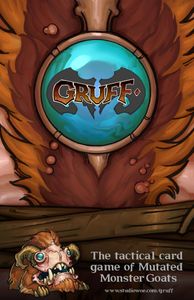2 Shepards!
A Battle for the Ages!
Ladies and Gentlemen, the Shepard's have come together tonight with the strongest goats they could raise. Neither will back down, neither will surrender. This, Ladies & Gentlemen, is GRUFF!

GAME DESCRIPTION: Gruff is a Customizable Card Game published by Studio Woe for 2-4 players. Players take the role of Shepard's to wage battle with others using their mutated goats, or Gruffs.
SET-UP: Depending how you draft, each player places 1 Shepard behind a row of their 3 Gruffs. Take 8 cards from the Gruffs deck (marked by their picture) and shuffle them together into a deck, then draw 5 cards. Finally, randomly choose the first player.
SHEPARD: Each Shepard has a life meter, which can be depleted when a Gruff attacks. They also have a Crazy meter, which determines what cards can be played.
GRUFF: Each Gruff has 3 stats. Mean is the attack of the gruff, and contributes to the Damage a Gruff deals when attacking. Fat is the defensive capacity of the gruff. Fat contributes to the Defense value of a Gruff when attacked. And Weird is added to your shepherd's Crazy when the Gruff is activated.

ORDER: Each turn consists of the following:
- Clean-up: Resolve your attack, remove your conditions from play, and if all your Gruffs are exhausted or dead, refresh your team.
- Activate: Turn one of your Gruffs sideways. Some Gruffs will have abilities activated at this point.
- Play: Each Gruff card has a number in the top left. You may play any number of cards provided the numbers in the top right added together never exceeds your Shepard's Crazy.
- Tactical: Finally, you may choose to have your active Gruff either Grow to gain 1 point in any stat, Move or change places with any gruff adjacent, Attack by moving the active Gruff in front of any Gruff to attack on Clean-up
ATTACK: At the beginning of your next turn, deal damage equal to your attacking Gruff's Mean to the Gruff being attacked. If your Damage is equal or greater than the Defense of the opposing gruff, kill that Gruff by flipping it's character card over, but keeping all effects on it and all stats the same. Excess damage is taken from the enemy Shepherd's Life. If the Damage is less, the Gruff blocks the damage completely. If there is no Gruff in the defending space, or the Gruff is dead, the Shepard takes all Damage.
WINNING: Once a Shepard hits 0, that player loses. The last player with Health left over wins.
CONCLUSION: Gruff is a card game through and through, with conflicts on rulings and effects that play off each other. If you like games like Magic the Gathering or Yu-Gi-Oh, you'll enjoy the fact that you can just pull this out and play it with anyone else easily. However, this is not the game that is going to convert any player to the TCG/LCG market. Take it for what it is, a combat card game with the ability to play with another player without too much effort or money put in.






